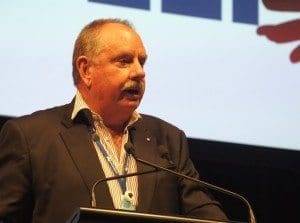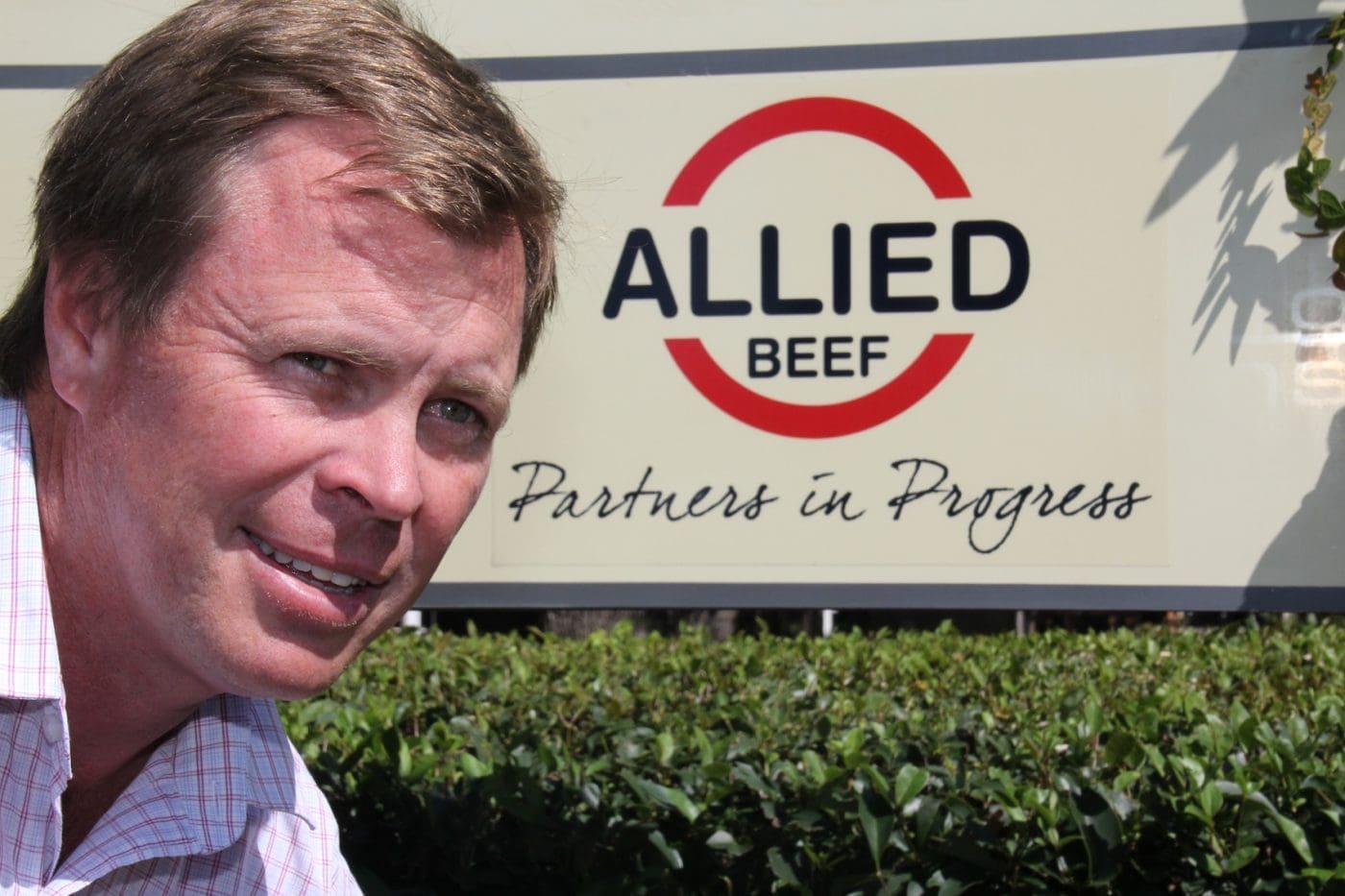Beef Central cast the net around to seek some industry opinion on the advancing beef carcase weights issue, discussed in detail in this separate report this morning.
Set out below are responses from Rangers Valley’s Don Mackay, president of the Australian Lot Feeders Association; NH Foods’ Stephen Kelly, chairman of the Australian Meat Processors Corporation; MLA general manager red meat innovation Dr Alex Ball, and supply chain manager, Allied Beef’s James Maclean.
Rangers Valley’s experience with heavier carcase weights
With average carcase weights of 445kg from its longfed Angus cattle, Rangers Valley’s branded beef program is as well-equipped as anybody in the Australian industry to pass comment on the impact of heavier carcase weights.
Apart from Wagyu, the 270-day grainfed Angus rolling out of Rangers Valley feedlot near Glen Innes in northern NSW produce some of the highest average carcase weights of any branded beef program in the country.
“If Australian beef is going to continue to strive for greater efficiency at the processing level, particularly as herd size declines in coming years, we have to look at getting more from the animals we’ve got,” managing director Don Mackay said.
“If you’re killing an animal at 9-12 months of age that has the genetic potential to produce a 360-400kg carcase, it’s an absolute waste, when cattle are going to be so short. We have to think about that in terms of the total production and supply in this country, otherwise overall beef volumes will inevitably decline even more than they otherwise would,” he said.
He was not suggesting for a moment that brand programs move ‘en masse’ to carcase weights as high as Rangers Valley’s, however.
“One of the big influences in advancing average carcase weights in Australia has been within the domestic market category, where retail butchers and supermarkets have progressively moved upwards in carcase weight, from around 200kg to 260kg or more,” Mr Mackay said.
“For example, the Coles Finest program for which Rangers Valley feeds, now wants carcases with minimum weights of 285kg. So it’s perhaps more rounding-up at the lower end, rather than adding weight at the top end, where the shift to heavier weights has happened, and may still happen.”
But as beef carcases got heavier, the perennial question was how to manage meal portion size from ever-larger primal muscles. That applies also to domestic supermarket programs, where on top of their regular carcase beef supply, many operators also buy a lot of boxed meat from carcases 330-350kg in weight.
A striploin or cube-roll from a 360kg carcase was a ‘very different looking piece of meat’ than the same portion cut to a specified weight from a 270kg carcase, Mr Mackay said.
“Certainly in our international markets, cut size is not a problem for us at all,” he said. “Domestically in Australia, though, it is still perceived to be a problem. But as the industry learns to break muscles up more, I think we are seeing a greater ability to manage larger cuts, and hence larger carcases.”
Cube roll was a good cut example, with an entire Rangers Valley cube-roll from a 370kg carcase being a ‘very large piece of meat.’
“The diameter of a more traditional Australian domestic cube roll can often be not much bigger than a closed fist,” Mr Mackay said.
“But it’s what consumers are used-to, and there are different ways to manage these larger cuts. Taking the spinalis muscle off the edge of the cube roll is just one example – treating it as a separate, specialised item – and I think the industry needs to think more about that in managing portion size.”
The one cut that Australians ate as a grilling cut that very few other countries did was rump, and increasingly, the rump was being broken down into the cap, centre-cut and other component parts, that deliver cut sizes that worked well from larger carcases, he said.
US market analyst Len Steiner recently told Beef Central that some US food service and retail operators had literally resorted to cutting familiar-shaped steak items like sirloins and rib-eyes in half, in order to manage the extreme cut size issue in the US.
Mr Mackay said another consideration was the potential for productivity improvement at the meatworks level from heavier bodies.
“Productivity improvement at plant level in Australia over many years has been reasonably low,” he said.
“Some of the increases in processing productivity in places like the US has come from more intensive feeding, and hence, larger carcases. The cost difference in killing a 400kg carcase compared to a 250-270kg carcase is very minimal. You end up with 60-70 percent more meat in the carton, for roughly the same killing cost.”
Apart from the subsidisation that went on in the US beef industry, one of the single biggest competitive differences between Australia and the US was the cost to slaughter.
“Obviously some of that is driven by low wages and so on, but carcase weight is a significant factor,” Mr Mackay said.
“Heavier carcases fill the carton better, deliver much lower processing costs per kilo, and there are flow-on effects. Hides are worth more, offals are worth more.”
While it was true that nobody in Australia was going to produce significantly heavier carcases simply for greater efficiency in processing, it was part of a bigger picture, he said.
Mr Mackay said the processing efficiency advantages in heavier carcases was evident even in cow slaughter for manufacturing beef. “It’s the primary reason why the heaviest cows on the meatworks grid always make considerably more money than lighter cows,” he said.
The US beef industry had done a ‘remarkable job’ in maintaining overall beef production levels as well as it had, given the major decline in beef herd size over the past ten years, Mr Mackay said.
“They’ve done that through intensive feeding, the use of technology and production tools like beta agonists and HGPs, and ever-increasing carcase sizes coupled with the ability to manage those bigger cut sizes.”
Processing costs a complex issue – but weight is part of the picture
Australian Meat Processors Corporation chairman Stephen Kelly said efficiency at meatworks level was a very complex issue, but certainly carcase weight played a role.
“Every plant is different. But the major cost of any abattoir is labour, so that is the primary factor in determining cost per kilogram of meat produced,” he said.
The manning of abattoirs depended more on the type of cattle being processed, rather than the weight of the carcase. For example, processing 400kg bulls required little labour in the boning room compared to 220kg grassfed yearling, due to the number of separate cuts being harvested and packaged.
However most medium to large beef processing plants killed multiple carcase categories each day, so manning had to reflect this.
Single category plants (examples: Kilcoy Pastoral Co’s Queensland plant, processing nothing but 100-day grainfed ox, or hot-boning plants like EC Throsby, Singleton) could both be very efficient, because there is no over-manning issue – despite their considerable differences in average carcase weight.
Mr Kelly agreed to try to illustrate some of the cost differences applicable to carcase weight using a ‘basic multi-category plant’, killing either 250kg or 300kg average weight carcases.
He suggested there could be a $7.50 to $12/head advantage (3-4c/kg carcase weight) in processing a 300kg carcase, all other criteria being equal, and taking into consideration slaughtering, boning and indirect costs. That outcome was based on the cost per head being the same, while the cost per kg will be slightly cheaper for the heavier carcase.
“But the benefit in processing heavier carcases is not only related to a reduction in fabrication costs,” Mr Kelly said.
“There is also a corresponding increase in value derived from meat, offal, hides and other items. Generally speaking, the heavier piece of meat (or offal, hide) attracts a higher selling price per kilogram.”
On top of the assumed production cost saving of $7.50-$12 a head, he suggested there could be perhaps $22-$30 in the extra return from additional meat, offal and by-products. That gave a total advantage of $30-42/head using a comparison between 250kg and 300kg average carcase weights.
However Mr Kelly warned that any production advantage in heavy carcases could easily be erased if the 250kg cow had 10mm of fat, and a 350kg cow had 35mm of fat.
“In this example, any advantage gained by the heavier carcase is lost due to poor yield recovery and lower priced product.”
Pros and cons in push to heavier carcase weights: MLA
MLA general manager red meat innovation Dr Alex Ball made the following observtions about increases in carcase weight.
“As carcase weight increases, the value of prediction on yield increases,” he said.
“Put simply, this is a result of fat being later maturing and therefore the variation in fat increases with weight and that results in yield being more valuable.
- “Additionally, as carcase weight increases, the need for ‘sub-primaling’ increases, for two reasons: to remove the intermuscular or seam fat which is now larger, and to allow more price pointing of cuts.”
As a word of warning, however – especially in a tough drought year like this – Dr Ball pointed out that as carcase weight increases, so does the mature size of the cow herd.
“So efficiencies gained in the processing sector may be offset by increased production costs. It’s a debate/comment worth having with the bull breeders of Australia,” he said.
Supply chain perspective: Lack of incentives seen
Supply chain manager James Maclean from Allied Beef agrees that carcase weight will be a consideration over the next few years, with inevitably short cattle supply looming across Eastern Australia.
“But there’s a big difference between what’s happened in the US, carcase weights-wise, and what may happen here,” Mr Maclean said.
“Under the US system, based on pricing linked to marbling through USDA quality grading, operators continue to get a higher price as more cattle are fed longer to grade USDA Prime and Choice. Longer days on feed and heavier carcases will generally increase the percentage of carcases grading USDA Prime and Choice, provided they are not discounted on maturity.
“In Australia, there is no real scope for 100-day cattle in reward on marbling. Perhaps the current beef industry language review will examine how the market interprets that, and whether there should be more scope for some additional meat quality attributes, based on rewarding those cattle that marble better,” Mr Maclean said.
“It’s true that some plants have better 100-day grainfed specs than others, but the problem is partly that Australia’s grainfed industry operates on a ‘days-on-feed’ outcome, rather than a quality outcome.”
“But currently, the rewards are not really there, for marbling performance.”
Another crucial factor in using the US as an indicator of what might happen in Australia was cost of gain.
In the US, cheap grain means cost of gain is significantly lower than the end-price, from a ration price perspective. As Beef Central’s regular feedlot trading budget shows, Southeast Queensland feedlots are currently reporting cost-of-gain on 100-day cattle at 280c/kg.
“But should we see finished cattle prices lift further, and grain prices weaken a little, I’d suggest a lot of 100-day cattle could be fed for more days. It comes back to grain price, cost of gain, and underlying market price.”
Click here to view this morning’s main story on increasing beef carcase weights.




